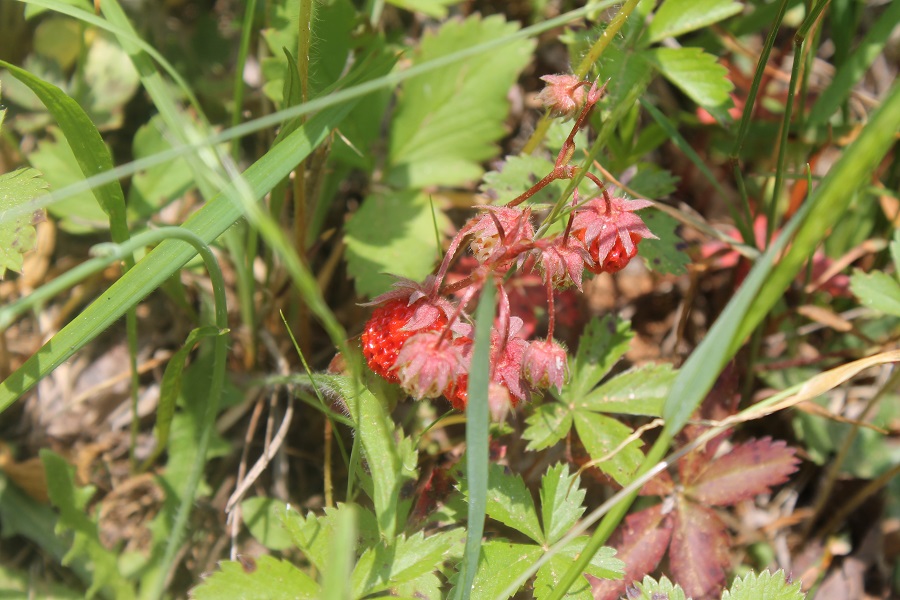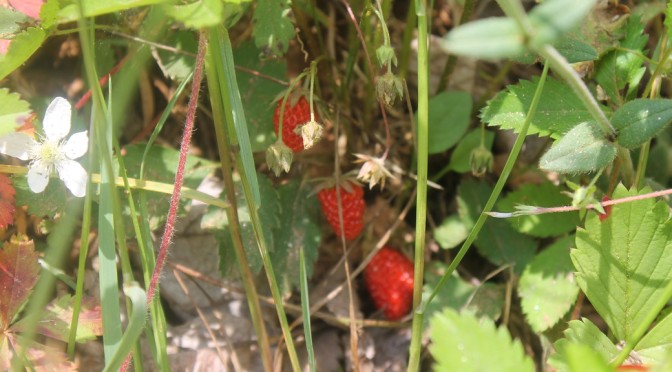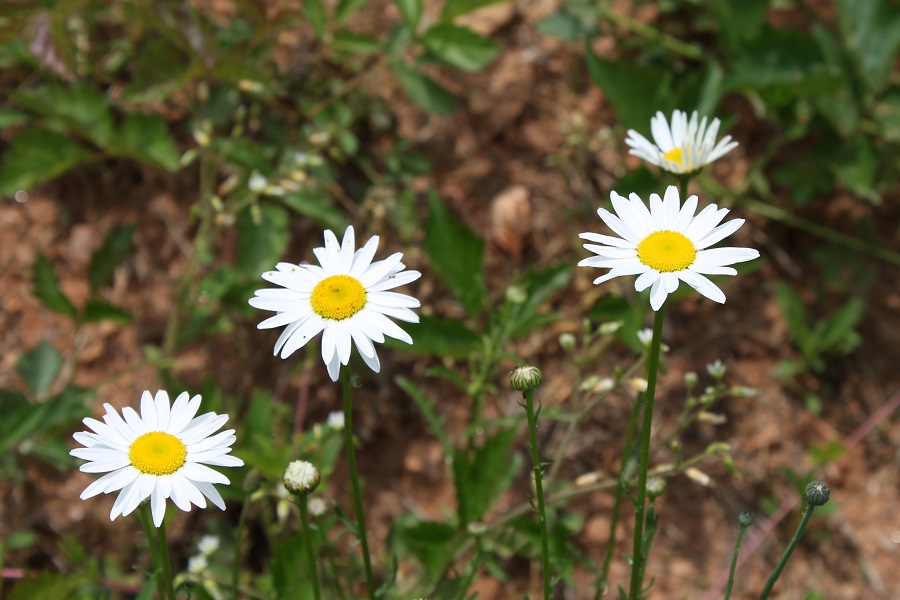by Mrs. Cog
The wonderful surprises that nature continues to bestow upon us at the new homestead never cease to amaze and delight us. While collecting some late Spring daisies for the kitchen counter vase, we discovered what appeared to be miniature strawberries growing around them.
Now the last time I picked an unknown plant to bring home and identify via my amazing googling abilities, I was stunned to find it was extremely poisonous and was called the flower of death. Cog and the teen still tease me about the episode. So proceeding with caution I began my investigation prior to collecting the specimens.
I turns out that many consider edible wild strawberries, which these indeed turned out to be, a delicacy. They are sweeter than the store bought or fresh picked larger strawberries that you are probably familiar with.
These self perpetuating treats reproduce via runners rather than seeds. They can be found growing in sunny meadows, near the edges of forests where the sun shines a good part of the day and even in your unmowed lawn if it has not been treated for weeds. These plants are now located all over the Northern hemisphere. People have even cultivated the wild strawberries as ground cover around their homes.
Some of the information about wild strawberries is misleading or just wrong as there are several different types. Edible wild strawberries have white blooms, as in the picture above. Mock strawberries, which are tasteless and some say toxic, have yellow flowers. Edible ones dangle from the vine, while the mock variety point up.
 It turns out, there are health benefits and medicinal properties in these small gifts. Packed with Vitamin C and antioxidants, these small treasures also have been used over the ages as treatments for various ailments. The berries will curb fever and have been proven to cure rheumatism, arthritis and gout.
It turns out, there are health benefits and medicinal properties in these small gifts. Packed with Vitamin C and antioxidants, these small treasures also have been used over the ages as treatments for various ailments. The berries will curb fever and have been proven to cure rheumatism, arthritis and gout.
Infusions and teas made with the leaves can cure diarrhea and gastric inflammations. Classified as an astringent, the leaves are also used to treat wounds, bruises and even sore throats.
Much smaller than greenhouse bred commercial strawberries, I can confirm that the wild version we discovered are sweeter and just delicious to wash and eat without even sprinkling sugar on top. They are perfect size to add to cereal, oatmeal or porridge. Try them on salads (mmm... maybe with walnuts, too), or add to your favorite juicing recipe to sweeten it up. They can be made into jam, baked in pies or tarts or used in a fresh fruit salad. This morning I am making gluten free strawberry and ground vanilla bean muffins. More recipe ideas are linked below.
So get out there and rummage around those daisies that may have popped up in your yard or a nearby patch of uncut growth. The season for these treats to bloom and produce berries runs April to June and you may be pleasantly surprised by what you find.
More Information:
Nutritionists have labeled strawberries a nutritional “superfood,” a result of it being an excellent source of antioxidants, Vitamin C, potassium, folate and fiber (World’s Healthiest Foods). http://www.goodfoodworld.com/2012/11/the-wild-strawberry-a-sacred-purifier/
The fruit ripens in late spring or early summer. Much smaller than commercial strawberries, it takes long to collect, but tastes much better. Stuff yourself with wild strawberries, collect them to use on cereal, in pancakes, oatmeal, fruit salad, sauces, or other desserts. They're so good, they're the symbol of perfect excellence. http://www.wildmanstevebrill.com/Plants.Folder/Strawberry.html
The name “strawberry” comes from “strewn berry” meaning the berries were strewn on the plants. That in time was shortened to strawberry. In the rose family strawberries aren’t really berries or fruit. They are enlarged ends of the plants’ stamen, the male part of the flower. http://www.eattheweeds.com/fragaria-virginiana-be-a-strawberry-sleuth-2/
These are typical phytochemicals found in wild strawberry: strawberry leaves are rich in tannins and ellagitannins, such as agrimoniin, pedunculagin, proanthocyanins, flavonoids, salicylic acid, caffeic acid, and chlorogenic acid. wild strawberries (fruits) are rich in ellagitannins, pelargonidin, cyanidin, ellagic acid. http://www.phytochemicals.info/plants/wild-strawberry.php
I try to restrain myself, but inevitably I end up picking some prematurely, not half the delight as the fully ripened berries - so I leave them be and just keep coming back to see how they are progressing. Happily, wild strawberry is one of those plants whose season is quite prolonged. Depending on factors such as exposure to sunlight and altitude it is possible to harvest them over a period of a couple of months. Of course, competition from birds and other critters can be tough. http://www.sacredearth.com/ethnobotany/foraging/wildstrawberries.php
Wild Strawberry Recipes: http://www.yummly.com/recipes/wild-strawberry
A wonderful .pdf file to download or print from the University of Alaska, Fairbanks (yes, these grow there as well) that includes recipes for jams, fruit leathers, strawberry syrup and more. http://www.uaf.edu/files/ces/publications-db/catalog/hec/FNH-00105.pdf
The awesomely (is that a word) sweet wild strawberries are the perfect ingredient to make Wild Strawberry Vinegar. Far superior to cultivated varieties, these ‘little balls of nectar’ are quite simply, heavenly, and the end product is a deep rich red strawberry vinegar that turns ordinary salad dressings into something sensational. http://www.eatweeds.co.uk/wild-strawberry-vinegar
We never met a strawberry we didn’t like. Especially at this time of year, when the beautiful summer berries are either in season or on their way, nothing seems to make as much sense for dessert as strawberry shortcake, strawberry pie (go on, make a pie with strawberry and rhubarb, too, for a classic June dessert), or just-plain strawberry with cream. Maybe with a little sugar. Hmm, perhaps not. Strawberries worth their weight at the farmstand should be as sweet as honey right now. (Oh, we’ve got a strawberry-rhubarb cobbler, too.) http://www.recipe.com/recipes/desserts/pie/strawberry/
Homemade wild strawberry ice cream recipe: http://honestcooking.com/wild-strawberry-ice-cream-recipe/


Hi, Mrs. Cog:
Yummmm!!! These truly are the best, both flavor-wise and just for their wonderful history. ‘Fraise du Bois’ originally grew in the forests of Europe and were considered a true delicacy by dilettante French aristocracy, worth hunting with little baskets, lots of servant/attendants and plenty of well-attended ‘Ohhh’s! and Ahhh’s!’ over wine and cakes and forest frolics.
According to interesting sources, it’s also the base word for the venerable Highland clan, the ‘Fra(i)sers’, who supposedly were granted that nom via royalty ‘connexions’/bestowed titles between Scotland and France – a very long-time relationship even prior to the ‘Bonnie Prince Charlie’ era. Makes for interesting reading, the ongoing connection between cuisine and politics. Cooks rule, BTW . . . :)
Anyway, kudos for finding/harvesting/enjoying these little beauties. Out here in the CA hinterlands, they would, indeed, be a novelty and surprise. So, granted that, imagine MY surprise when a six-pack of them turned up at the local hardware store-cum-garden outlet supply. Say ‘WHA?
So, I popped for them, carried them back to the eyrie, and planted all six of them in spots where I could monitor their success in an otherwise not-natural environ. News flash for those who might be interested in trying them on: They are growing in the sun; they are growing in the shade; they are growing in the rock garden; they are growing in the row garden. They are growing! :) So do try these if you can find them. Tiny bursts of very intense flavor that leave you wanting MORE.
In the meantime, a plea from the far West: We are suddenly bereft of anything related to scented pelargoniums/geraniums here in central CA. Any suggestions? Sympathy? Whatever. I’ve always grown these, am starting a new garden at a new home and suddenly they are AWOL. Have asked everywhere and, sad to say, the local stockers are all saying ‘not this year; nothing available.’ WHAT? So I am on a hunt. Help welcome and much appreciated. If you have a good source for such, please provide. I’m not the only one who will say thank you.
:) LionLady
Nice work on the wild strawberry transplants. Nothing like an “invasive species” that you can eat year after year huh? lol
I picked, cleaned and froze about a pint of tiny wild strawberries both today and yesterday. The buggers are everywhere! I was also doing maintenance on the front flower beds near the road today and kept finding them here and there tucked under bigger leaves. I just ate them as I worked.
We got a line on a strawberry farm with larger commercial berries to pick not a half hour from here in “peak berries”, may go pickin’ this weekend. :-) I feel a jam day coming on… if only I had some mason jars.
Hi Mrs Cog:
Well, it seems you have the ‘gatherer’ part of the Mountain started now. Wild strawberries are great. Wild black berries are my favorite though. Hope you have some of those. And then there is CD’s favorite, kudzu. Of course he will have to leave some of those for your soon to be acquired goats. Then you will start the ‘hunter’ phase of the Mountain. Regression complete.
Don’t laugh…Kudzu might just be one of CD’s favorites once he knows just how delicious and nutritious it really is!
http://www.thekitchn.com/did-you-know-you-can-eat-kudzu-92488
http://www.livestrong.com/article/474310-how-to-cook-eat-kudzu/
http://www.elanaspantry.com/ingredients/kudzu/
Lets not forget the wild onion, dandelion, and pokeweed
These things grow great even when the garden isn’t:-)